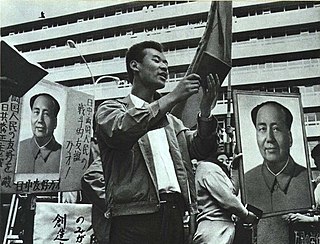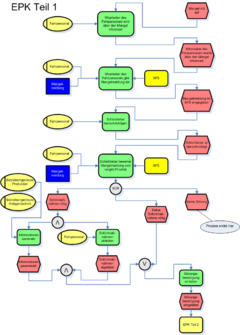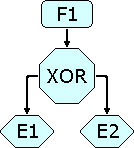
The critical path method (CPM), or critical path analysis (CPA), is an algorithm for scheduling a set of project activities. A critical path is determined by identifying the longest stretch of dependent activities and measuring the time required to complete them from start to finish. It is commonly used in conjunction with the program evaluation and review technique (PERT).

August-Wilhelm Scheer is a German Professor of business administration and business information at Saarland University, and founder and director of IDS Scheer AG, a major IT service and software company. He is known for the development of the Architecture of Integrated Information Systems (ARIS) concept.

A flowchart is a type of diagram that represents a workflow or process. A flowchart can also be defined as a diagrammatic representation of an algorithm, a step-by-step approach to solving a task.

Business process modeling (BPM) in business process management and systems engineering is the activity of representing processes of an enterprise, so that the current business processes may be analyzed, improved, and automated. BPM is typically performed by business analysts, who provide expertise in the modeling discipline; by subject matter experts, who have specialized knowledge of the processes being modeled; or more commonly by a team comprising both. Alternatively, the process model can be derived directly from events' logs using process mining tools.
Dynamic enterprise modeling (DEM) is an enterprise modeling approach developed by the Baan company, and used for the Baan enterprise resource planning system which aims "to align and implement it in the organizational architecture of the end-using company".
A piping and instrumentation diagram is a detailed diagram in the process industry which shows the piping and process equipment together with the instrumentation and control devices.
The term conceptual model refers to any model that is formed after a conceptualization or generalization process. Conceptual models are often abstractions of things in the real world, whether physical or social. Semantic studies are relevant to various stages of concept formation. Semantics is fundamentally a study of concepts, the meaning that thinking beings give to various elements of their experience.

The Mongolian People's Army, also known as the Mongolian People's Revolutionary Army or the Mongolian Red Army was an institution of the Mongolian People's Revolutionary Party constituting as the armed forces of the Mongolian People's Republic. It was established on 18 March 1921 as a secondary army under Soviet Red Army command during the 1920s and during World War II. In 1992, the army's structure changed and then reorganized and renamed as the Mongolian Armed Forces.

Business Process Model and Notation (BPMN) is a graphical representation for specifying business processes in a business process model.

In software engineering, structured analysis (SA) and structured design (SD) are methods for analyzing business requirements and developing specifications for converting practices into computer programs, hardware configurations, and related manual procedures.

The Chengdu Metro is the rapid transit system of Chengdu, the capital of Sichuan, China. With the opening of Line 1 on 27 September 2010, the system consists of 13 subway lines and 1 light rail line. It has subsequently undergone rapid expansion. Since the opening of Lines 6, 8, 9, and 17 on 18 December 2020, the Chengdu Metro is the 4th longest metro system in the world.

In systems engineering, software engineering, and computer science, a function model or functional model is a structured representation of the functions within the modeled system or subject area.

A functional flow block diagram (FFBD) is a multi-tier, time-sequenced, step-by-step flow diagram of a system's functional flow. The term "functional" in this context is different from its use in functional programming or in mathematics, where pairing "functional" with "flow" would be ambiguous. Here, "functional flow" pertains to the sequencing of operations, with "flow" arrows expressing dependence on the success of prior operations. FFBDs may also express input and output data dependencies between functional blocks, as shown in figures below, but FFBDs primarily focus on sequencing.

Zhang, Zhaohuan (张照寰) was born in Zhenjiang, China, in 1925. He graduated from the Faculty of Medicine, Shanghai Medical College in 1950. Because of his outstanding school performance and academic potential, he was offered a lectureship by his alma mater upon graduation—a practice that is still in vogue in almost all universities in China when recruiting exceptional faculty members is difficult. In the eight years that followed, he worked there first as a lecturer and then an associate professor and associate director.

Vienna Hotel Group Limited, operating as Vienna Hotels is a hotel chain in China, headquartered in Shenzhen North Railway Station, Bao'an District, Shenzhen.

The Resident Identity Card is an official identity document for personal identification in the People's Republic of China. According to the second chapter, tenth clause of the Resident Identity Card Law, residents are required to apply for resident identity cards from the local Public Security Bureau, sub-bureaus or local executive police stations.

TMSR-LF1 is a 2 MWt molten salt reactor (MSR) pilot plant located in northwest China.

Mao Zedong, the longtime Chairman of the Chinese Communist Party and the founder of the People's Republic of China, was reported to have expressed his gratitude to the Japanese military and political figures who visited China in the 1950s and 1970s. Mao said that the Japanese invasion of China had united Chinese people and allowed the Chinese Communist Party to win the Chinese Civil War. In the 21st century, these remarks by Mao caused strong reactions on the internet in China. With the 2020 Hong Kong Diploma of Secondary Education Examination (HKDSE) history subject controversy on the historical understanding of Japan's invasion of China, these remarks have returned to the spotlight on Hong Kong and mainland Chinese websites. The word "thanks" expressed by Mao has been also interpreted by some observers as dark humour.
Wen Tiejun is a Chinese agricultural economist who is a professor at the Renmin University of China.

Lost in the Stars is a 2022 Chinese mystery crime film directed by Cui Rui and Liu Xiang, and starring Zhu Yilong, Ni Ni and Janice Man. The film is adapted from Alexey Korenev's 1990 Soviet comedy film A Trap for Lonely Man and French playwright Robert Thomas' 1960 play Trap for a Lonely Man. It tells the story of He Fei's wife Li Muzi who disappeared mysteriously during the wedding anniversary trip. It's a film about a story of a shocking case. The film's style have been described by some critics as "Hitchcockian".


















